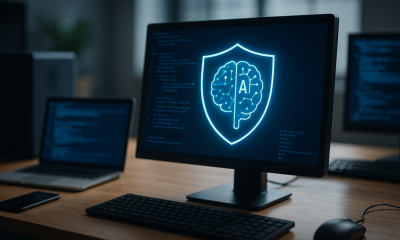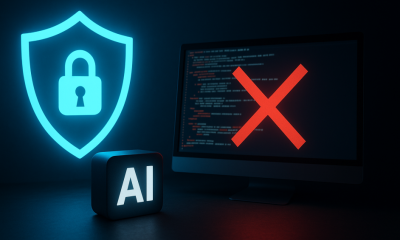Thought Leaders
The Trillion-Dollar Arms Race: How AI Is Reshaping Cybersecurity’s Asymmetric Battlefield

The Scale of Modern Cybersecurity
Cybersecurity has evolved into a trillion-dollar industry—a figure that puts it on par with the GDP of entire nations. To put this in perspective, the global cybersecurity market rivals the economic output of countries like Indonesia ($1.4 trillion) or the Netherlands ($1.0 trillion). This massive investment reflects not just the value of what we're protecting, but the relentless nature of the threat landscape that has emerged over the past quarter-century.
The Fundamental Asymmetry
This industry has always thrived on what can be characterized as asymmetric innovation. The relationship between attackers and defenders represents one of the most fascinating examples of competitive dynamics in the modern economy. The mathematics are stark and unforgiving: the dark side needs to succeed only once, while defensive solutions must catch as many attacks as possible—ideally all of them.
This asymmetry creates a unique innovation environment. Attackers can afford to fail repeatedly, learning from each attempt and refining their methods. Defenders, conversely, must maintain near-perfect vigilance across an ever-expanding attack surface. Having observed this evolution for almost 25 years, the emergence of AI-powered attacks represents both a predictable progression and a fundamental shift in the nature of this asymmetric warfare.
Historical Paradigm Shifts: Lessons from the Past
The innovation from the dark side has consistently led to paradigm shifts in the adoption of market technologies throughout the cybersecurity industry. A clear example of this asymmetric innovation in action occurred in the early 2000s, when worms targeting Microsoft operating systems drove the exponential rise of Network Intrusion Prevention Systems (NIPS).
The debates within organizations were intense—should they deploy additional inline technology that could potentially cause latency or network disruption? These philosophical discussions were settled within minutes when worms completely wreaked havoc in enterprise environments. The risk of network performance impact paled in comparison to the devastation these attacks could cause. That paradigm shift happened almost overnight, creating an entirely new market segment worth billions of dollars.
We are about to witness a similar transformation in the world of AI—asymmetry in action once again.
The Current Email Security Paradigm Under Threat
For the longest time, the cybersecurity industry has focused on ensuring that all emails are scrutinized for malicious links and malicious attachments. An entire ecosystem of companies has grown around these fundamentals, creating sophisticated detection engines, sandboxing technologies, and URL analysis platforms. This approach has been the bedrock of email security for over two decades.
However, the latest AI-based techniques present new challenges for traditional email security approaches. Cybercriminals have developed what represents perhaps the most elegant solution to the traditional arms race: attacks that eliminate malicious indicators entirely while leveraging artificial intelligence to create perfect social engineering campaigns.
These new conversation hijacking attacks demonstrate the power of AI in the hands of threat actors. Rather than relying on malicious links or attachments that security systems can detect, attackers now use large language models to generate entire fabricated email conversations that perfectly mimic internal company communications. The sophistication is remarkable—these AI systems can adapt to a company's communication style, replicate organizational jargon, and create realistic timestamps that follow typical work patterns.
The Intelligence Advantage
What makes this development particularly concerning is how attackers leverage publicly available information. Professional platforms like LinkedIn provide detailed organizational hierarchies, revealing payment approval chains and communication patterns. When combined with AI's ability to process and synthesize this information at scale, attackers can now craft highly personalized, contextually accurate attacks with minimal effort.
The psychological manipulation has also evolved. These AI-generated attacks exploit authority bias, confirmation bias, and social proof simultaneously. When employees receive what appears to be an internal email thread showing clear chains of approval, they process it as routine business correspondence rather than external deception.
The Coming Paradigm Shift: Lessons from History
Just as worms in the early 2000s forced organizations to rapidly adopt NIPS technology despite concerns about network performance, AI-powered conversation hijacking attacks are poised to create the next major paradigm shift in cybersecurity. The fundamental assumption underlying decades of email security investment—that threats can be detected through technical analysis of malicious content—is being systematically dismantled.
From an economic perspective, this represents a seismic shift in the cost-benefit equation. For attackers, AI dramatically reduces the marginal cost of highly sophisticated, customized attacks. What once required extensive manual research and crafting can now be automated and scaled across thousands of targets simultaneously. For defenders, traditional signature-based detection, URL filtering, and sandboxing technologies require complementary approaches when there are no technical indicators to analyze.
The ecosystem of companies built around scanning for malicious links and attachments will need to adapt their approaches and expand their capabilities to address threats that operate without traditional technical indicators.
The Data Strategy Imperative: Redefining External Attack Surface
This evolution brings data strategy to the forefront of organizational security planning in ways previously unimagined. For decades, security teams have focused on the traditional external attack surface—open ports, exposed services, and vulnerable applications. This surface has now expanded to include a fundamentally different element: the intelligence organizations inadvertently share that enables attackers to learn and mimic internal patterns.
The question is no longer just what technical vulnerabilities exist, but what behavioral and communication intelligence is being exposed to potential adversaries. Organizations must critically evaluate how much they share that is necessary versus what could potentially create venues for attackers to learn organizational patterns, communication styles, and operational workflows. Every LinkedIn profile, press release, earnings call transcript, and public interview becomes potential reconnaissance material for AI-powered attacks.
This represents a paradigm shift in how organizations must think about information sharing. The traditional risk-benefit analysis of public communications must now factor in the possibility that this information will be used to train AI models designed to impersonate internal communications with near-perfect accuracy.
The Zero Trust Evolution: From Devices to Communications
The cybersecurity industry has already embraced the zero trust model for logins and devices, fundamentally changing how organizations approach authentication and access control. The principle of “never trust, always verify” has become standard practice for network access, requiring continuous validation of user identity and device integrity regardless of location or previous authentication.
Now, facing AI-powered conversation hijacking attacks, organizations must confront a mind-boggling question: do we need to extend zero trust principles to email communications themselves? While the concept of treating every email as potentially compromised may seem extreme, the sophistication of AI-generated attacks is forcing this uncomfortable conversation.
The parallels to the zero trust evolution are striking. A decade ago, many organizations resisted implementing zero trust architectures, viewing them as overly complex and potentially disruptive to business operations. Today, zero trust is considered essential cybersecurity hygiene. The question is whether we're approaching a similar inflection point with email communications.
Rethinking Email Trust Assumptions
The fundamental challenge is that email has long been treated as a trusted communication channel within organizations. Internal emails, especially those that appear to come from known colleagues and follow established conversation threads, carry an implicit trust that recipients rarely question. AI-powered conversation hijacking exploits this trust assumption with devastating effectiveness.
A zero trust approach to email would require organizations to treat every email communication as potentially compromised, regardless of apparent sender, domain, or conversation history. This would necessitate verification protocols for any action requested via email, particularly those involving financial transactions, sensitive data access, or operational changes.
Creating Business Process Moats
From a business perspective, this threat environment will necessitate creating additional protective moats around any processes that deal with financial transactions and sensitive data. Organizations will need to implement multi-layered verification protocols that go beyond traditional email-based approvals.
The most successful enterprises will be those that architect their critical business processes with the assumption that any email communication could be compromised or fabricated. This zero trust approach to email communications means building verification mechanisms that operate outside of email channels—secure messaging platforms, voice verification protocols, and in-person confirmations for high-value transactions.
While implementing zero trust for email communications may seem as disruptive as zero trust networking once did, the alternative—maintaining trust assumptions that AI can systematically exploit—presents far greater risk. Organizations that proactively adopt email zero trust principles will likely find themselves better positioned when these attacks become more widespread.
The Defender's Dilemma: Detecting the Undetectable
From a defender's perspective, this represents yet another significant challenge in an already complex threat landscape. The fundamental question becomes: how can security teams easily spot this wave of attacks and block them when they contain no traditional indicators of compromise?
Traditional security tools that have formed the backbone of email security—spam filters, malicious link detection, and attachment scanning—become largely irrelevant. The attack vector shifts from technical exploitation to pure social engineering, delivered through communications that are technically legitimate but contextually fraudulent.
Building Resilience in an AI-Driven Threat Landscape
The most successful organizations will be those that recognize this as more than a technology problem. It's a business process and cultural challenge that requires treating communication integrity as a core operational risk alongside data protection and business continuity.
Security training must evolve beyond generic phishing exercises to include exposure to AI-generated, fabricated conversation threads that look and feel like authentic internal communications. Organizations must foster environments where challenging authority in the name of security is not just allowed but expected.
The Path Forward
As AI continues to advance, so too will the ability to create increasingly sophisticated forgeries. The proliferation of writing assistance tools is creating more uniform communication patterns, making it harder to distinguish authentic personal styles from sophisticated AI-generated content.
The trillion-dollar cybersecurity industry finds itself at an inflection point. The fundamental asymmetry that has always defined this space is being amplified by AI, but so too are the opportunities for innovative defense. Organizations that understand these dual trends—threat evolution and defensive innovation—will be best positioned to navigate this new landscape.
The arms race continues, but the weapons have fundamentally changed. In this new era of AI-powered threats, success will belong to those who can match technological sophistication with process innovation and cultural adaptation. The asymmetry remains, but the battlefield has evolved—and with it, the strategies required for victory.












